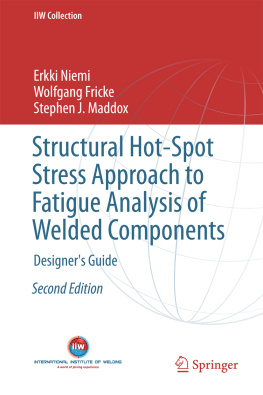Khalfallah - Structural Analysis 1
Here you can read online Khalfallah - Structural Analysis 1 full text of the book (entire story) in english for free. Download pdf and epub, get meaning, cover and reviews about this ebook. City: London;UK, year: 2018, publisher: John Wiley & Sons, Incorporated;ISTE Ltd, genre: Computer. Description of the work, (preface) as well as reviews are available. Best literature library LitArk.com created for fans of good reading and offers a wide selection of genres:
Romance novel
Science fiction
Adventure
Detective
Science
History
Home and family
Prose
Art
Politics
Computer
Non-fiction
Religion
Business
Children
Humor
Choose a favorite category and find really read worthwhile books. Enjoy immersion in the world of imagination, feel the emotions of the characters or learn something new for yourself, make an fascinating discovery.
- Book:Structural Analysis 1
- Author:
- Publisher:John Wiley & Sons, Incorporated;ISTE Ltd
- Genre:
- Year:2018
- City:London;UK
- Rating:5 / 5
- Favourites:Add to favourites
- Your mark:
- 100
- 1
- 2
- 3
- 4
- 5
Structural Analysis 1: summary, description and annotation
We offer to read an annotation, description, summary or preface (depends on what the author of the book "Structural Analysis 1" wrote himself). If you haven't found the necessary information about the book — write in the comments, we will try to find it.
Structural Analysis 1 — read online for free the complete book (whole text) full work
Below is the text of the book, divided by pages. System saving the place of the last page read, allows you to conveniently read the book "Structural Analysis 1" online for free, without having to search again every time where you left off. Put a bookmark, and you can go to the page where you finished reading at any time.
Font size:
Interval:
Bookmark:

In memory of my father, Tahar
In memory of my wife, Mrs Nadjet Khalfallah-Boudaa
To my family
20 Ramadan 1437 h
Series Editor
Gilles Pijaudier-Cabot
Salah Khalfallah

First published 2018 in Great Britain and the United States by ISTE Ltd and John Wiley & Sons, Inc.
Apart from any fair dealing for the purposes of research or private study, or criticism or review, as permitted under the Copyright, Designs and Patents Act 1988, this publication may only be reproduced, stored or transmitted, in any form or by any means, with the prior permission in writing of the publishers, or in the case of reprographic reproduction in accordance with the terms and licenses issued by the CLA. Enquiries concerning reproduction outside these terms should be sent to the publishers at the undermentioned address:
ISTE Ltd
27-37 St Georges Road
London SW19 4EU
UK
www.iste.co.uk
John Wiley & Sons, Inc.
111 River Street
Hoboken, NJ 07030
USA
www.wiley.com
ISTE Ltd 2018
The rights of Salah Khalfallah to be identified as the author of this work have been asserted by him in accordance with the Copyright, Designs and Patents Act 1988.
Library of Congress Control Number: 2018943087
British Library Cataloguing-in-Publication Data
A CIP record for this book is available from the British Library
ISBN 978-1-78630-338-7
The main objective of this volume is to provide students of civil, mechanical, aeronautical and marine engineering as well as those interested in structural analysis with the essentials for analyzing statically determinate structures. This book allows them to acquire sufficient knowledge to study and analyze statically determinate structures. The reader will find a series of exercises at the end of each chapter that can be used to deepen their knowledge and improve their ability to master statically determinate structure analysis methods.
This volume covers aspects of structural analysis such as trusses, beams, frames, cable structures and arch structures. The last chapter looks at influence lines for live loads, which play a role in the design phase of statically determinate structures.
This book is the first of two volumes. It consists of two parts. Each chapter of the book is constructed in a specific way: an illustration of the objectives and the parts covered, a general introduction, a theory of the proposed approach, a numerical study of some examples and a summary at the end. Each chapter ends with a series of problems and exercises.
The first part includes a general introduction to structural analysis (). The load magnitude is evaluated according to European standards, including those adopted by France. The second part describes statically determinate structure analysis methods.
This part is divided into eight separate chapters. , in which two types of arches are selected: semicircular and parabolic. The loads proposed here are concentrated and uniformly distributed. The last chapter illustrates the influence lines of the internal or external actions that are built under the effect of a moving unitary load along a beam, a frame or a truss.
Finally, we hope that our approach in this books publication will meet the needs of students interested in this scientific and technical subject. Nevertheless, we are very aware that the work presented is not exempt from mistakes. For this reason, we warmly welcome any corrections and comments, which will improve future editions of this book. Comments or suggestions can be sent to the email addresses found on the website www.freewebs.com/khalfallah/index.htm.
Salah KHALFALLAH
May 2018
Introduction to Structural Analysis
The teaching objectives for this chapter are as follows:
- the role of structural analysis teaching;
- the concept of a structure;
- the development of structural analysis methods;
- the distinction between categories of structures;
- the calculation of a statically indeterminate structure.
This chapter is descriptive and gives a general presentation of the preliminary aspects of statically determinate structure analysis. In the first part, we present the concept of a structure, the objectives to be achieved during structural analysis teaching and the history of its development. In the second part, we look at structural classification based on the structural dimension. Finally, we give the calculation of the degree of static indeterminacy of the structures.
The primary role of structural study and analysis is to determine the internal actions and the support reactions of a structure subjected to mechanical loads, imposed deformations and settlements of supports. An action can mean either a force and/or a moment. In the same way, a deformation can mean a displacement and/or a rotation.
Structures are classified into two broad categories: (1) statically determinate structures and (2) statically indeterminate structures. The three static equilibrium equations are used to analyze statically determinate structures. In this case, the support reactions can be determined using only static equations. As a result, internal actions, such as a bending moment, a torsion moment, a shear force, and a normal force, can be deduced using the internal equilibrium equations.
On the contrary, for statically indeterminate structures equilibrium equations are not sufficient to calculate the unknowns of the problem. This means that the number of unknowns (the support reactions) is strictly greater than that of the equations. The difference between the number of unknowns of the problem and the equations is called the degree of static indeterminacy of the system or structure.
The word structure in the field of mechanics indicates any solid body that satisfies the following conditions:
- 1) the presence of a material characterized by mechanical properties;
- 2) the structure studied has a geometry or a form;
- 3) the structure is linked to the external environment through the supports;
- 4) the body is subjected to external loading.
The definition of a structure is clearly projected in .

Structural analysis is the calculation of responses when a structure is subjected to a set of external loads. In general, the structural response is characterized by the determination of internal actions or deflections at any point in the structure. To achieve this goal, it is necessary to use a mathematical method, an experimental test, or an analytical or numerical model.
In addition, the main role of structural analysis is to study structural performance when it is subjected to the effects of the external environment, such as a set of external actions, a movement of the support or a temperature change. The common features of structural performance, which are important during the design phase, are as follows:
- internal forces: axial force, shear force, bending moment and torsion moment;
- support reactions;
- the deflections that occur after external loads are applied.
Font size:
Interval:
Bookmark:
Similar books «Structural Analysis 1»
Look at similar books to Structural Analysis 1. We have selected literature similar in name and meaning in the hope of providing readers with more options to find new, interesting, not yet read works.
Discussion, reviews of the book Structural Analysis 1 and just readers' own opinions. Leave your comments, write what you think about the work, its meaning or the main characters. Specify what exactly you liked and what you didn't like, and why you think so.










